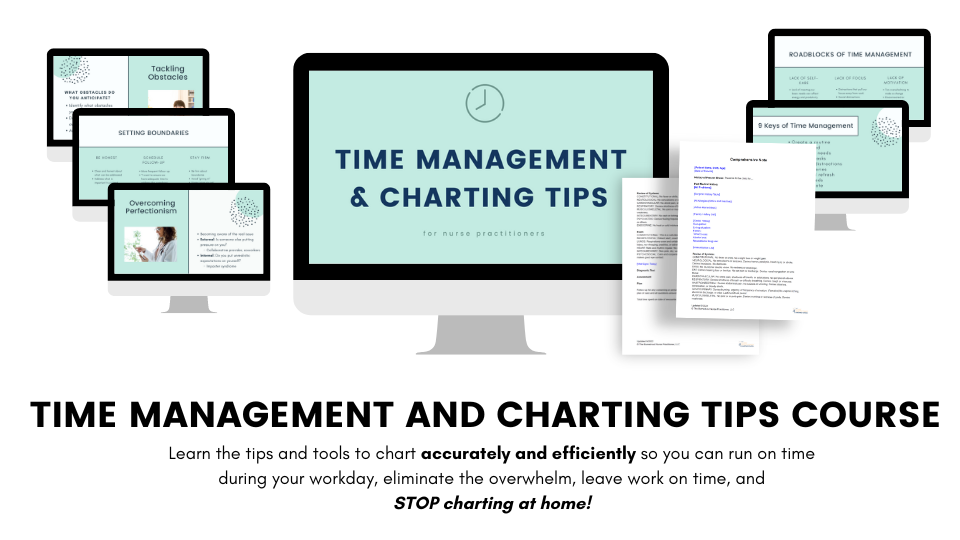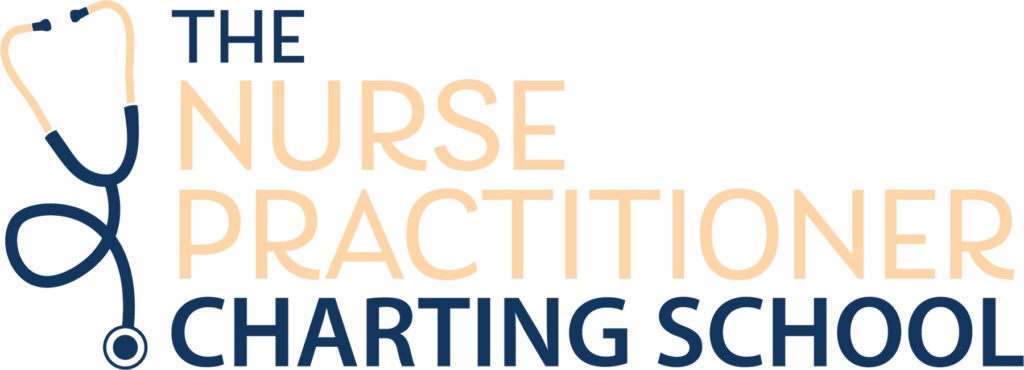“You have to do something different in order to see different results.”
-Albert Einstein.
I have seen so many nurse practitioners experience charting burnout, lack of work-life balance, and ultimately nurse practitioner burnout. So many nurse practitioners have to stay late at the office or bring their charts home. This in turn causes added stress, burnout, thoughts of leaving healthcare altogether. It seems like there is no way out, but I can reassure you there is.
I created the C.H.A.R.T.S. method to help nurse practitioners form healthy charting habits- and stick with them! This article will break down the C.H.A.R.T.S. method you can finally improve charting as a nurse practitioner.
Utilize the C.H.A.R.T.S. method to improve charting as a nurse practitioner.
C- Commit to making a change.
The most important step to improve charting as a nurse practitioner is to commit to putting in the effort to do so. It is important for nurse practitioners to reflect on how their current charting burnout is affecting their life. Many APRNs are staying late at the office or bringing charts home.
With both of these examples, the nurse practitioners are spending more time at work and less time with family. This creates a lack of work-life balance.
Nurse practitioners have to commit to make a change. The best way to stay adherent to the goal is to discover their “why.” A “why” is the reason the nurse practitioner wants to make a change. Oftentimes the true why is a lot deeper than many people realize. There are often internal motivators for wanting to make a change (such as to provide a better life for our children than we had as a child).
And if we can remind ourselves of the reasons why, it is a lot easier to stay strong when times get tough. Take some time to reflect on your own reasons why you want to improve charting as a nurse practitioner. Do you want to improve your charting to have a better work-life balance? To spend more time with your family? To have the energy to implement self-care? To finally prioritize your own health and wellness?
H- Have a goal.
In order to make any kind of habit change, we need to establish a goal. If we do not have a goal, there is no way to know if we have made it. Think about your patients that have achieved goals. Those that are wanting to lose weight to get their life back. Or those that were severely injured in an MVA and told they would never walk again. The patients that were 100% committed to a goal were more likely to achieve it.
A goal set to improve charting as a nurse practitioner can look different for each nurse practitioner. For example, maybe one APRN wants to have all charts signed by the end of a work day but is ok with catching up on reviewing past medical records for 30 minutes at home. Or maybe the nurse practitioner has admin time during the week so they have 3 extra hours to catch up. Or maybe they want to have all their work completed so they have extra time to start a health coaching side hustle.
Setting a specific, achievable goal will help improve charting as a nurse practitioner.
A- Awareness.
In order to know where you want to go, you have to know where you are starting. It is difficult to advise APRNs on how to improve charting as a nurse practitioner if they do not know what they are struggling with.
I encourage nurse practitioners to begin tracking their time. Write down how long it takes to see a new patient vs. established patient. A chronic visit vs. acute visit. How much time does it take to complete medication refills, analyze diagnostics data, review past medical records, or respond to patient messages.
Once the nurse practitioner has tracked the time, complete a time audit. Are there certain tasks the nurse practitioner can delegate? Are there social distractions that prevent the APRN from signing charts right after the patient encounter? Are there charting shortcuts within the electronic medical record (i.e. templates or smart phrases) that would help decrease some of the time spent charting.
In order to improve charting as a nurse practitioner, it is vital to become aware of where we are currently at.

R- Replace-make a change.
When it comes time to replace the poor charting habit, nurse practitioners are already committed, have set a goal, and are aware of their starting point. This creates a stronger base as the nurse practitioner makes a positive charting habit change.
Creating a new habit should be specific to the nurse practitioner. Maybe the APRN realized they were spending too much time explaining to the patient how to get to the lab after the clinic visit. Instead this nurse practitioner can have the medical assistant or nurse wrap up the visit and take the patient to the lab. Or maybe the nurse practitioner wants to work on avoiding too much information and rather create a problem focused chart note.
There are many ways to improve charting as a nurse practitioner and I encourage NPs to make it specific for their practice. If changing a charting habit (such as implementing a virtual scribe) seems too overwhelming right now, then choose a habit that is more exciting and achievable.
Making a change should be motivating and empowering rather than distressing. This is how we can improve charting as a nurse practitioner.
T- Tackling obstacles.
If there is one thing to expect in healthcare it is to expect the unexpected. Nurse practitioners know how many challenges or unexpected obstacles they can face during their work day. APRNs are aware of the challenges of the modern healthcare system.
But when they try to improve charting as a nurse practitioner, many forget to expect obstacles. There will be roadblocks. For example, maybe you were working on delegating more tasks to the medical assistant or nurse. But then another support staff quit and all of a sudden your MA/nurse is now having to support two providers.
Or maybe you were working on implementing virtual scribes into your practice. But the clinic manager does not support improving work-life balance and overcoming nurse practitioner burnout. Maybe you have a lot of added stress at home with a family member’s health that drains your mental and physical energy.
Expect these obstacles and formulate a plan to overcome them. Know that you will have a bad day. That there will be other factors that try to prevent you from reaching your goals. That there will be challenges and hardships.
If APRNs realize there will be these challenges, they can create a plan to keep going. They can remember their “why” and commitment to achieving their goal. They can continue to improve charting as a nurse practitioner.
S- Small changes.
I do recommend that APRNs start with small, achievable goals. These smaller goals make it easier for nurse practitioners to succeed and motivate them to keep going.
When APRNs set out to pay off $60,000 of student loan debt, they don’t do it all at one time. It is easier to break apart that large number and pay off $10,000 at a time. These smaller steps allow us to stay focused and avoid getting overwhelmed by these changes.
Think about implementing smart phrases or a template into the electronic medical system. Maybe the nurse practitioner is able to save 2 minutes per patient. If the APRN sees 20 patients a day, that is 40 extra minutes available! We do not have to make enormous, difficult changes in order to improve charting as a nurse practitioner.
I also want nurse practitioners to focus on changing one charting habit at a time. This allows APRNs to put all of their attention on the most important change. Once the first goal is achieved, the nurse practitioner can then move on to the next goal.
Think about a time when you were completely focused on changing a habit. Did you have better success when you were attentive to one change at a time? These small, attainable steps help to improve charting as a nurse practitioner.
In order to improve charting as a nurse practitioner and change our charting habits is not easy. It takes time. It takes effort. It takes doing things we have never done before.
But improving our charting as a nurse practitioner is worth it. It allows nurse practitioners to avoid the charting burnout. It allows nurse practitioners to improve their work-life balance. It allows nurse practitioners to overcome nurse practitioner burnout. It allows nurse practitioners to get their life back.
Additional charting tips.
If you need more assistance to improve charting as a nurse practitioner, check out The Nurse Practitioner Charting School.
When it comes to charting, The Nurse Practitioner Charting School is the one stop for all documentation resources created specifically for NPs!
- Check out The Nurse Practitioner Charting School’s blog page for helpful charting tips!
Also checkout the paid courses:
- Time Management and Charting Tips Course: Learn the tips and tools to chart accurately and efficiently so you can run on time during your workday, eliminate the overwhelm, leave work on time, and STOP charting at home!
- Billing and Coding Course: Outpatient Visits: Feel confident choosing the correct Evaluation and Management CPT® code for an outpatient patient visit, so you can avoid over coding (and under coding!) ensuring you receive proper insurance reimbursement!
- Legal Issues with Charting Course: Learn how to prevent a malpractice suit and put your mind at ease regarding legal issues of charting.
- Charting as a Nurse Practitioner Student Course: Going through nurse practitioner school is incredibly overwhelming. Don’t stress about the charting.
Utilize The NP Charting School’s Comprehensive List of Smart Phrases: Get access to over 100 smart/dot phrases to save time so you can STOP charting at home!

Erica D the NP is a family nurse practitioner and The Nurse Practitioner Charting Coach. Erica helps nurse practitioners STOP charting at home! Erica created The Nurse Practitioner Charting School to be the one stop for all documentation resources created specifically for nurse practitioners. Learn more at www.npchartingschool.com
Follow on Facebook: The Nurse Practitioner Charting SchoolAnd on Instagram: @npchartingschool
Free training: 4 charting tips to help nurse practitioners get their time back! Sign up here!



